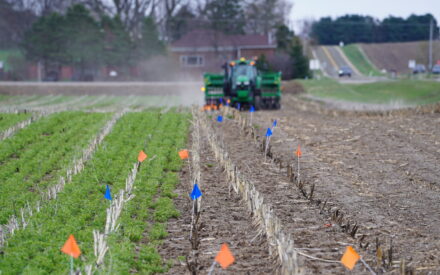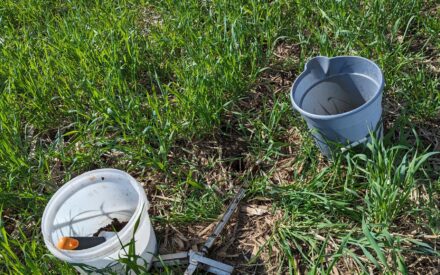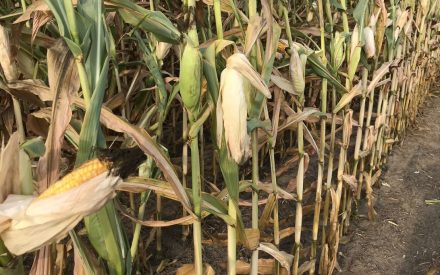The decision to harvest corn stover from fields must be based on a balance between feed and bedding needs for livestock relative to soil health and nutrient management goals. Stover is the stalks, leaves, husks, and cobs left after corn grain harvest. Removing corn stover removes valuable nutrients from the field and increases the potential for soil crusting, erosion, and—long term—reduced water infiltration rates due to reduced soil organic matter (OM) levels.
It is relatively easy to understand and estimate nutrient removal. Mechanical harvest and removal of corn stover removes approximately 4.6 pounds of P2O5 and 32 pounds of K2O per ton of 15% moisture stover. The value of these two nutrients to the subsequent crop needs to be taken into account when deciding to harvest stover. With current fertilizer prices, that value would be approximately 4.6*$0.60 = $2.76 and 32*$0.40 = $12.80 for a total of $15.56 per ton of stover with 15% moisture. Later harvest of stover will reduce the amount of nutrients removed, as rain will leach potassium out of the leaves and husks. Potassium is the most leachable nutrient because in plants it is held in mineral form. Conversely, phosphorus is held in organic compounds and is not readily leached – so stover harvest timing does not affect removal levels as much.
Removing corn stover will also remove nitrogen, sulfur, and various micronutrients from the field. Each ton of dry matter (DM) corn stover contains approximately 12-15 pounds of nitrogen and 1 pound of sulfur. The economic value of this loss is less clear for these nutrients, as they normally leach through the soil readily and are managed on an annual need basis. However, they are held within soil organic matter, as we will discuss shortly, and each farm should put some value onto these lost nutrients based on the field and management characteristics that apply to their situation.
Removal of stover may have a short-term yield benefit due to greater availability of nitrogen, as less stover helps the soil warm up earlier in the season and stover temporarily ties up nitrogen during its breakdown process. However, frequent stover removal over an extended period of time will deplete soil nitrogen and may reduce available nitrogen as compared to a field that has not had stover removed. Estimating the amount of nitrogen removed in harvested corn stover is difficult for these reasons. Soil sampling and testing is the best way to stay ahead of nutrient removal from fields that experience frequent stover harvest. See Nutrient Application Guidelines for Field, Vegetable, and Fruit Crops in Wisconsin (A2809) for information on soil sampling and testing procedures.
We should note that grazing removes less nutrients than mechanical harvest, as most of the nutrients livestock consume are returned to the soil through urine and feces. See our Grazing Corn Stalks article for more information on grazing corn stalks.
Although leaving corn stover in a field has multiple benefits, there are certain pest issues to be addressed before deciding to harvest stover or leave it in the field. Many disease-causing pathogens overwinter in soil and plant residue. For instance, if a grower has had a year with high severity of diseases such as tar spot, ear and stalk rots etc. there is a strong chance that retaining corn stover would essentially mean harboring disease inoculum for the following year. A survey study in Michigan shows that fields where crop-residue was not tilled/removed showed higher incidence of ear rot infections and mycotoxins. Secondly, the left-over plant residue can enhance survival capacity of insects such as western bean cutworm and other ear-damaging insects by providing additional shelter and moisture while they borrow into soil to overwinter as pupae. Therefore, observations from in-season field scouting must be referred to before deciding while keeping in mind the overall economics of the farm and the crops (host vs non-host) planned for the following year.
Crop residue reduces soil erosion by minimizing the impact of rain drops on soil surface and reducing speed of surface water flow. Rain drops impact bare soil with force resembling a small explosion. The resulting soil thrown into the air is easily washed away by water running over its surface. If the raindrop falls over a piece of crop residue, the energy of the falling raindrop is absorbed by the crop residue rather than exploding on the soil surface. Crop residue also forms small dams on the soil surface, slowing the flow of water across the field. Slowing the water results in more time for the water to infiltrate into the soil. Corn stover has more value in sloped environments than in level environments from a water erosion perspective. Weigh the need for residue to mitigate erosion in your environment.
Looking for information on grazing corn stalks? Check out the companion to this article, Grazing Corn Stalks.
Published Oct. 21, 2024

 ▶ Unlocking the Potential of Biological Nitrogen Fixation in Corn
▶ Unlocking the Potential of Biological Nitrogen Fixation in Corn ▶ Considerations for 2026 Seed Selection
▶ Considerations for 2026 Seed Selection ▶ Evaluating MRTN Rates for Corn Grain and Silage After Manure Application
▶ Evaluating MRTN Rates for Corn Grain and Silage After Manure Application ▶ Practices to Optimize the Nutritive Value of Corn Silage
▶ Practices to Optimize the Nutritive Value of Corn Silage


